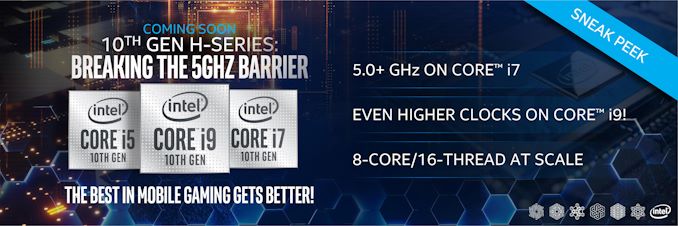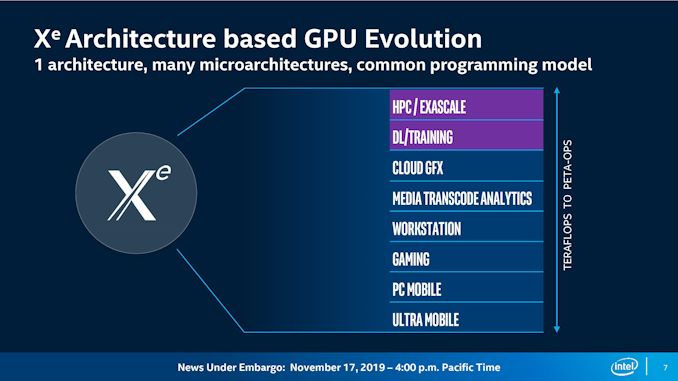Intel at CES 2020: 45W 10th Gen Mobile CPUs Soon, Tiger Lake with Xe Graphics Later
by Dr. Ian Cutress on January 6, 2020 1:00 AM EST- Posted in
- CPUs
- Intel
- Trade Shows
- 45W
- 10nm
- Core-H
- Tiger Lake
- Xe
- 10th Gen Core
- Comet Lake
- CES 2020

As we move into 2020, there is a lot of talk about what Intel’s 2020 plans will be. Discussions about the expansion of Intel’s 10nm process node products, such as Ice Lake, beyond the mobile platform are often very heated, especially when we have limited information out of the company directly. For CES 2020, Intel has disclosed a couple of products for consumption: moving its 10th Gen mobile CPU line in to 45 W hardware, but we also had a couple of details about the post-Ice Lake hardware, called Tiger Lake.
With the 45 W mobile CPUs, it’s important to note that we are talking about Comet Lake here – Intel’s latest 14++ nm microarchitecture derived from the original Skylake but optimized from the latest Coffee Lake hardware. What this means for users is essentially a small improvement in frequency: Intel isn’t saying that much with what the new CPUs will bring at this point, but they are pointing out that they will be hitting 5.0 GHz with the new 45W Core i7 parts, and more than 5.0 GHz with the Core i9 hardware. I would assume this would mean that Intel is going to introduce both Turbo Boost Max 3.0 and its Velocity Boost technology to the mobile platform, which would target the best cores in the chip as well as use additional thermal headroom to get that extra frequency. Intel did not disclose if the turbo power increases with the new hardware.
We’ve seen a couple of designs already announce they will be using the 45W CPUs: Acer’s ConceptD Ezel and Ezel Pro laptops, along with Lenovo’s Y740S gaming laptop. Intel has stated that it expects its hardware to be in the market soon, with a full disclosure about the platform ‘very soon’, however it turns out that this won’t be in January. To be honest, if we’re so close to launching the product, I’m surprised as to why Intel isn’t disclosing.
The other part to Intel’s disclosure at CES is Tiger Lake. What is Tiger Lake, you may ask – it’s the next mobile platform beyond Ice Lake. Bearing in mind that Intel has been speaking about Ice Lake a while, and we now finally have top tier partners with 1065G7 designs, we’re still waiting for Intel’s mid-tier and lower-tier partners to come out with the platform. So we’re still a long way away from Tiger Lake, unless Intel wants to move beyond Ice Lake quickly.
However, regarding Tiger Lake specifically, Intel did confirm that it has Xe graphics. Whether this is related to the DG1 silicon that the company has spoken about recently isn’t clear, but Tiger Lake is monolithic and the Xe graphics inside will provide full INT8 support for AI workloads (which will be supported through Intel DL Boost). This would be built on the Xe-LP microarchitecture, which is targeting sub-25W power on the GPU. Tiger Lake also continues with AVX-512, but also upgrades the Gaussian Neural Accelerator for voice analysis to GNA 2.0. Intel will say more about Tiger Lake at its press event on Monday.
Intel also briefed us about its new Ghost Canyon NUC 9 kit, which uses Intel’s upgradeable element form factor as well as an 8-inch desktop GPU. The NUC is a full 5.0 liter size, which completely ignores the original NUC size that the platform was built on, however Intel is claiming 9th Gen 45W CPU support up to 5.0 GHz, with upgradeable units coming later. We have a separate article on this.
Carousel image is the Acer ConceptD 7 Ezel, one of the new laptop designs using the new 10th Gen Core H-Series CPUs.













57 Comments
View All Comments
ksec - Monday, January 6, 2020 - link
>Intel also briefed us......It is very clear, from their marketing they want to dominate the PR space with Intel still has so many great product in the pipeline, you might as well wait to buy from Intel rather than AMD.
I hope the Lisa Su's CES talk will reveal more information on Zen 3. At the point in time Intel does not deserve to enjoy any of its current success.
DannyH246 - Monday, January 6, 2020 - link
Yeah i totally agree. After years of doing the bare minimum there have been tons of Intel 'future' articles on here recently. Its basically a poor attempt to stay relevant and keep in people's minds.ironargonaut - Monday, January 6, 2020 - link
Today article for you,"AMD’s Picasso platform, featuring its Zen+ cores and coupled with a Vega iGPU, has been a tremendous improvement for AMD. But Intel’s Ice Lake platform runs circles around it."
https://www.anandtech.com/show/15213/the-microsoft...
scineram - Wednesday, January 8, 2020 - link
A year old article, liar.Haawser - Monday, January 6, 2020 - link
So is this 45W 'Base TDP' or 45W actual max TDP ? Because they're not even close to being the same thing.Ian Cutress - Monday, January 6, 2020 - link
Intel always quotes the TDP as the sustained power draw. It goes without saying these days. Turbo power has the name 'PL2'vFunct - Monday, January 6, 2020 - link
These should have LPDDR4 & WiFi6 support, right?I'd expect these in MacBook Pro 16".
e36Jeff - Monday, January 6, 2020 - link
LPDDR4 is all about low power, you probably wouldn't bother with pairing it to a 45W CPU.TheinsanegamerN - Monday, January 6, 2020 - link
LPDDR4X is currently being sold in 3733 MHz configurations with 10th gen processors, which is much faster then most laptop DDR4 setups. Why not pair it with a 45 watt CPU, you might, you know, want good battery life when not hammering the system.Spunjji - Monday, January 6, 2020 - link
It has higher latency, and the high RAM clock-speeds don't make much difference to systems without an iGPU doing heavy lifting.It might make some sense if these processors had a proper 10th gen GPU, but they don't.